Fig. 2.
Reduced peri-plaque astrocyte coverage in AQP4 deficient 5xFAD mice. a Super-resolution imaging demonstrates a mesh of GFAP labeled processes surrounding the plaque core in a wild-type 5xFAD mouse. b Aβ, GFAP and AQP4 immunofluorescence showing astrocyte processes around and within plaques of Aqp4+/+ and Aqp4−/− 5xFAD mice. The dotted square area denote the region shown in c. c Boundaries of segmented plaque interior and plaque periphery ROIs (yellow) superimposed on the corresponding GFAP image of astrocyte processes used to determine the extent to which astrocytes surround and infiltrate plaques. d GFAP enrichment, defined as average GFAP intensity within the indicated area divided by average GFAP intensity in the surrounding field of view, from within (‘plaque interior’) and around (‘plaque periphery’) plaques displayed as the cumulative frequency for all plaques from Aqp4+/+ and Aqp4−/− 5xFAD mice. e Average GFAP enrichment within and around plaques for all measured plaques in each individual Aqp4+/+ or Aqp4−/− 5xFAD mouse (Aqp4+/+ n = 8, Aqp4−/− n = 5; ** p < 0.01, *** p < 0.001 by unpaired t-test)

